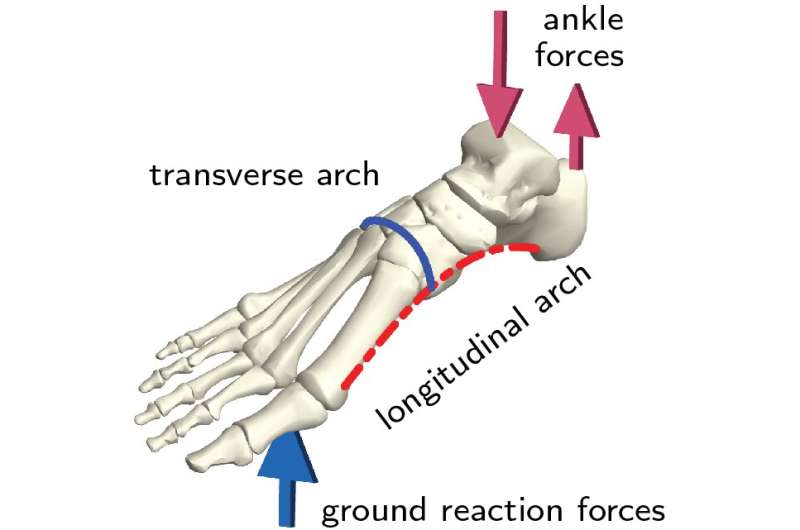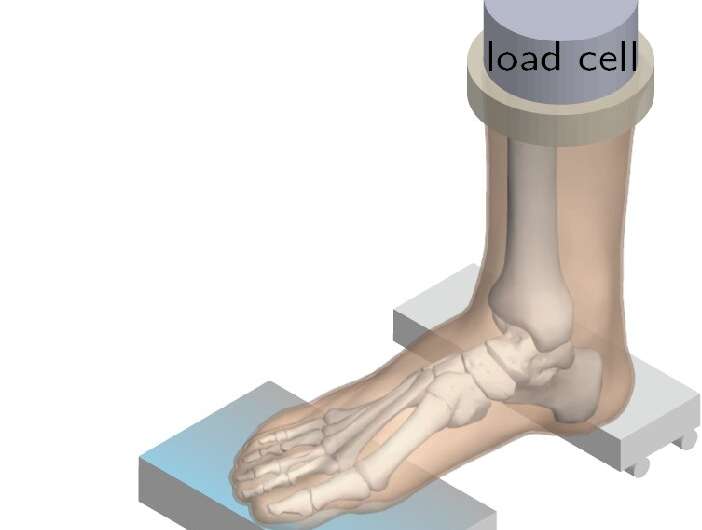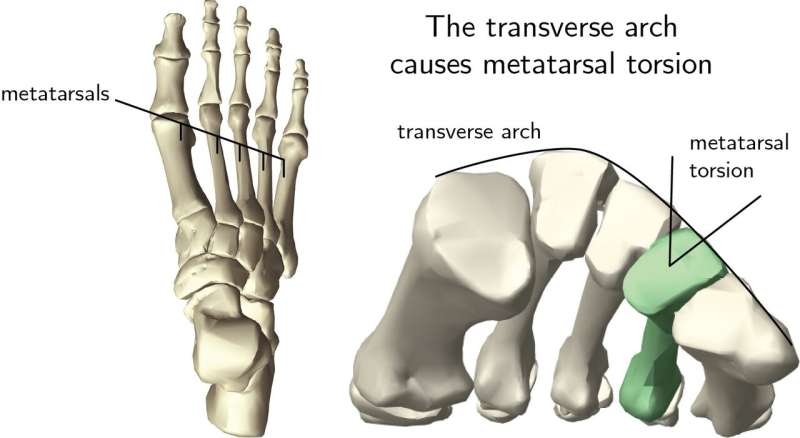Overlooked arch in the foot is key to its evolution and function

long-overlooked part of the human foot is key to how the foot works, how it evolved, and how we walk and run, a Yale-led team of researchers said.
The discovery upends nearly a century of conventional thinking about the human foot and could open new avenues to explore in evolutionary biology as well as guide new designs for robotic and prosthetic feet, said the study team.
The discovery, made by an international team of researchers and led by Yale engineer Madhusudhan Venkadesan, was published Feb. 26 in the journal Nature. The team was led jointly by Venkadesan, Shreyas Mandre from the University of Warwick, and Mahesh Bandi from the Okinawa Institute of Science & Technology (OIST).
When humans walk and run, the front of each foot repeatedly pushes on the ground with a force exceeding several times the body's weight. Despite these strong forces, the human foot maintains its shape without severely bending. Such stiff feet—unique to humans among primates—were important for the evolution of bipedalism.
What makes human feet so stiff? According to conventional thinking, it's mainly the longitudinal arch of the foot. This arch runs from heel to forefoot and is reinforced by elastic tissues underneath it. The arch and tissues create a bow-and-string structure that for nearly a century was considered the main source of the foot's stiffness.
But the foot has a second arch that runs across the width of the midfoot, known as the transverse arch. Venkadesan and his colleagues investigated the transverse arch, which had not been studied previously. They performed a series of experiments,using mechanical mimics of the foot, cadaveric human feet, and fossil samples from long-extinct human ancestors and relatives (hominins). Their results show that the transverse arch is the main source of the foot's stiffness.
The reason the transverse arch is so important can be found in your wallet. Take out a dollar bill, hold it at one end, and the dollar flops around. But press your thumb down to give the dollar some curvature, and it stands out straight.
"That type of effect also works in the foot," said Venkadesan, assistant professor of mechanical engineering and materials science. "It's not as simple as a sheet of paper because there are many other tissues and structures in the foot, but the principle turns out to be the same."
Using mathematical analysis and experiments, they gleaned the mechanical principle for why curvature induces stiffness—namely that bending a curved structure causes the material to also stretch. Even a thin sheet of paper is quite stiff if you try to stretch it. The transverse curvature engages this stretching stiffness to stiffen the whole structure, explained the researchers.
Because the foot is a complicated, multi-functional structure, it is not possible to modify just the transverse arch to test the theory without affecting other parts. So, using experiments on mechanical mimics of the foot, the researchers came up with a novel idea to see whether the transverse arch works the same way in real human feet.
"We found that transverse springs, which mimic tissues spanning the width of your foot, are crucial for curvature-induced stiffness," said Ali Yawar, a Ph.D. student in Venkadesan's lab. "So we expected that stiffness would decrease in real human feet if we were to remove the transverse tissues and leave everything else untouched."

Together with Steven Tommasini, a research scientist at the Yale School of Medicine, they conducted experiments on the feet of human cadavers.
"We found that the transverse arch, acting through the transverse tissues, is responsible for nearly half of the foot's stiffness, considerably more than what the longitudinal arch contributes," said Carolyn Eng, an associate research scientist in Venkadesan's lab.
These results may also explain how the 3.66 million-year-oldAustralopithecus afarensis, the same species as the fossil Lucy, could have walked and left a human-like footprint despite having no apparent longitudinal arch. Working with Andrew Haims, a professor at the Yale School of Medicine, the researchers developed a new technique to measure transverse curvature using partial skeletons of the foot. By applying this technique to fossil samples, includingA. afarensis, they traced how the transverse arch evolved among early hominins.

"Our evidence suggests that a human-like transverse arch may have evolved over 3.5 million years ago, a whole 1.5 million years before the emergence of the genus Homo, and was a key step in the evolution of modern humans," Venkadesan said.
The findings also open new lines of thought for podiatry, as well as the fields of evolutionary biology and robotics, the researchers said.
More information: Stiffness of the human foot and evolution of the transverse arch, Nature (2020). DOI: 10.1038/s41586-020-2053-y , nature.com/articles/s41586-020-2053-y
Journal information: Nature
Provided by Yale University




















